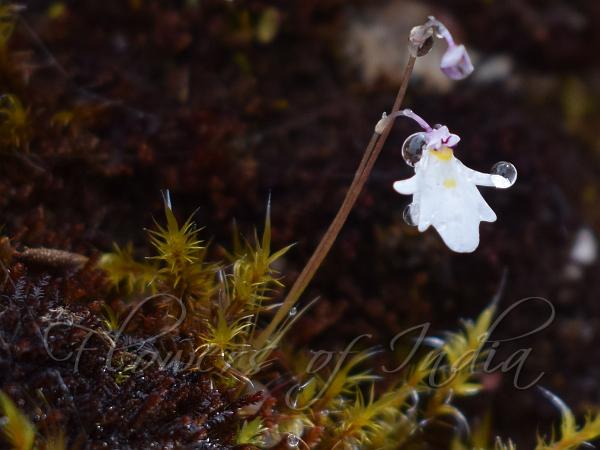|
| East-Himalayan Bladderwort |
|

|

| File size | 349903 |
| Original date | 10/1/19 11:06 AM |
| Resolution | 1800 x 1350 |
| Flash | Flash did not fire |
| Focal length | 40.0mm |
| Exposure time | 1/800s |
| Aperture | 4.8 |
| Focus Distance | |
| Metering Mode | Center weighted average |
| Camera make | NIKON CORPORATION |
| Camera model | NIKON D5300 |
| Sensor type | OneChipColorArea |
|
|
|
|
Photo: |
Botanical name: Utricularia brachiata Family: Lentibulariaceae (Bladderwort family)
East-Himalayan Bladderwort is a small perennial
carnivorous plant that grows on rocks. Leaves are few, from tuber,
hairless; leaf blade kidney-shaped, 1-3 cm x 2.5-6 mm, membranous,
base heart-shaped and narrowed onto long leaf-stalk, margin entire, tip
rounded to notched. Flowers are borne in erect, 3-8 cm, 1- or
2-flowered clusters. Flower-cluster-stalk is round, 0.2-0.4 mm thick.
Flower-stalks are spreading, 2-8 mm, thread-like, dorsiventrally
compressed. Sepals are 3-4 mm, hairless; lower lobe oblong, much
smaller than upper lobe, tip notched; upper lobe round, tip notched.
Flowers are white, with a yellow spot at base of lower lip and violet
streaks on upper lip; lower lip nearly round, distinctly 5-lobed; spur
narrowly cylindric, 2 or more times as long as upper sepal, tip blunt;
palate with a slightly raised rim, fringed with moniliform hairs; upper
lip much shorter than upper sepal, tip 2-lobed. East-Himalayan
Bladderwort is found in forests among bryophytes on rocks, at altitudes
of 2600-4200 m, from Nepal to NE India to Myanmar. Flowering:
July-September.
| Identification credit: Krishnapriya M P | Photographed in Dzongri, West Sikkim. |
• Is this flower misidentified? If yes,